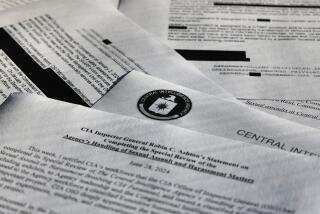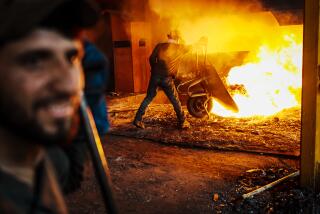CIA expanding presence in Afghanistan
WASHINGTON — The CIA is deploying teams of spies, analysts and paramilitary operatives to Afghanistan, part of a broad intelligence “surge” that will make its station there among the largest in the agency’s history, U.S. officials say.
When complete, the CIA’s presence in the country is expected to rival the size of its massive stations in Iraq and Vietnam at the height of those wars. Precise numbers are classified, but one U.S. official said the agency already has nearly 700 employees in Afghanistan.
The influx parallels the U.S. military expansion and comes as the nation’s spy services are under pressure from Army Gen. Stanley A. McChrystal to improve intelligence on the Taliban and find ways to reverse a series of unsettling trends.
Among them are a twofold increase in the number of roadside bombs, a growing sophistication in the kinds of assaults aimed at coalition troops and evidence that a Taliban group has developed an assembly-line approach to grooming suicide bombers and supplying them to other insurgent organizations.
U.S. officials have also been alarmed by a more sophisticated suicide attack: sending multiple fighters armed with guns to carry out coordinated assaults before detonating their bombs.
The spies are being used in various assignments -- teaming up with special forces units pursuing high-value targets, tracking public sentiment in provinces that have been shifting toward the Taliban and collecting intelligence on corruption in the Afghan government.
The intelligence expansion goes beyond the CIA to involve every major spy service, officials said, including the National Security Agency, which intercepts calls and e-mails, as well as the Defense Intelligence Agency, which tracks military threats.
The Obama administration is under pressure to show progress in Afghanistan, calculating that it has only until next summer before public support for the war effort collapses.
The deployments coincide with new warnings from U.S. spy services that the insurgency in Afghanistan has continued to gain territory and strength.
“The Taliban is at its most capable level since 2001, when it was ejected from the country,” said a Defense Department official who has access to classified intelligence estimates. The official, and others, spoke on condition of anonymity because of the sensitivity of the subject.
The official said the Taliban’s geographic gains have slowed only because it has already pushed into almost every area with a significant Pashtun population, the tribal networks that make up the Taliban’s home turf.
“They seem never to have a shortage of manpower,” the official said. “And there doesn’t appear to be any shortage of funding.”
Officials said the insurgency is believed to have 15,000 to 20,000 fighters. The estimates are broad, officials said, because there are loose affiliations among the groups, each of which has fighters with varying commitments to the cause.
“You’re not talking about fixed formations that rely solely on full-time combatants,” a U.S. counter-terrorism official said. “Numbers ebb and flow; bands of fighters appear and vanish.”
CIA spokesman Paul Gimigliano declined to comment on the scope of the agency’s presence in Afghanistan. But a U.S. intelligence official said that spy agencies “anticipated the surge in demand for intelligence.” The official said the intelligence community “has, for some time now, been deploying more officers to Afghanistan.”
The CIA’s buildup is the latest in a series of escalations there. After having only a few operatives there after the Sept. 11 attacks, the agency’s presence climbed to about 150 by the end of 2001, and 300 at the close of 2005.
A recent Senate report criticized the CIA’s role in Afghanistan over the last eight years, saying the agency provided large amounts of money and support to warlords, some of whom had ties to the drug trade and parlayed their U.S. backing into high-level positions in the government.
The agency’s station is based at the U.S. Embassy in Kabul, the Afghan capital. It is led by a veteran with an extensive background in paramilitary operations, officials said. But the bulk of the CIA’s workforce is scattered among secret bases and military outposts that dot the country.
Most recently, the CIA has been preparing to deploy Crisis Operations Liaison Teams, small units that are attached to regional military commands, giving officers access to information gathered by the CIA as well as satellites and other sources.
One of the largest concentrations of CIA personnel is at Bagram air base north of Kabul, the headquarters for U.S. military special operations forces and for years the site of a secret agency prison.
McChrystal is expected to expand the use of teams that combine CIA operatives with special operations soldiers. In Iraq, where he oversaw the special operations forces from 2003 to 2008, McChrystal used such teams to speed up the cycle of gathering intelligence and carrying out raids aimed at killing or capturing insurgents.
“He was able to plan during the day and do raids at night, sometimes multiple raids if he could move the information quickly enough,” said a former senior U.S. military intelligence official who worked closely with McChrystal in Iraq. “What he’s trying to do is get his decision cycle quicker than the bad guys.”
Afghanistan presents intelligence officials with steep challenges. Current and former CIA officials said that operatives and analysts account for only about one-third of the agency’s footprint in Afghanistan. The others are involved in support functions -- such as providing security and managing computer systems -- that are particularly daunting in Afghanistan because of the country’s size and the woeful state of its infrastructure.
The CIA is also carrying out an escalating campaign of unmanned Predator missile strikes on Al Qaeda and insurgent strongholds in Pakistan. The number of strikes so far this year, 37, already exceeds the 2008 total, according to data compiled by the Long War Journal website, which tracks Predator strikes in Pakistan.
The agency recently submitted a request for additional Predators from the Air Force, which manages the U.S. drone fleet, one official said. For years, the CIA drones were operated from inside Pakistan, but some are also flown from an air base across the Afghan border near Jalalabad.
A drone strike last month killed Pakistan Taliban chief Baitullah Mahsud. U.S. officials said they are watching closely to see whether his death leads to even a temporary drop in the number of suicide bombings.
Mahsud’s organization had become a major supplier of suicide bombers to other insurgent groups, training attackers that in some cases would be deployed to carry out strikes in Pakistan or Afghanistan.
“He turned it into a business,” the Defense Department official said. “Putting people through a process to indoctrinate them, prepping them to execute and then basically they can be bartered or sold.”
Though other U.S. officials said Mahsud did not appear to have been motivated by financial gain, they did confirm the supplier arrangement.
“He didn’t sell suicide bombers like a commodity for profit,” said a U.S. counter-terrorism official. “He’d offer resources -- in this case human beings ready to die -- to his sympathizers in exchange for things he needed. These were deals among tribal figures, not outsourcing agreements among corporations.”
For eight years, the CIA’s main priorities in Afghanistan were to hunt for Al Qaeda, manage relationships with warlords -- doling out inducements that included cash and, in some cases, Viagra -- and rebuild the Afghan spy service. The difficulty of that task was underscored this month by the assassination of the service’s No. 2 official.
But the agency’s role is likely to shift under McChrystal, who has placed a greater emphasis on protecting civilians and rooting out government graft.
U.S. spy agencies have already stepped up their scrutiny of corruption in Kabul. The recent Senate report described a wiretapping system activated last year that is aimed at tracing ties between government officials and drug kingpins in the country.
--
More to Read
Sign up for Essential California
The most important California stories and recommendations in your inbox every morning.
You may occasionally receive promotional content from the Los Angeles Times.










